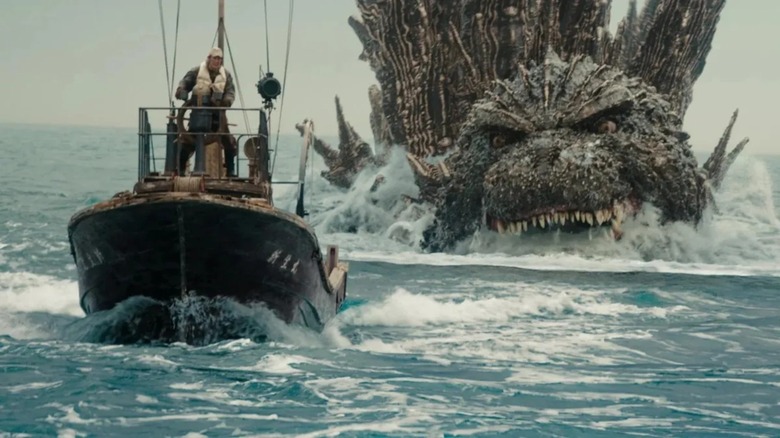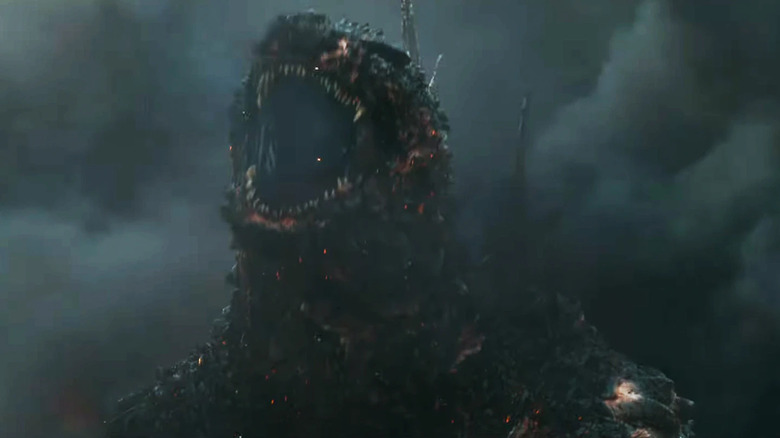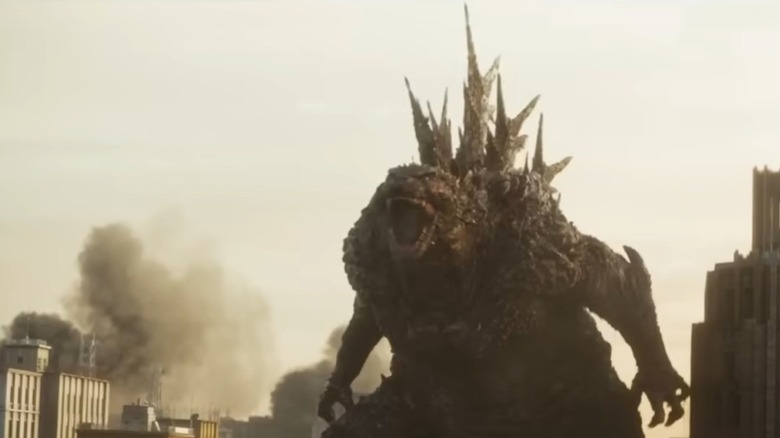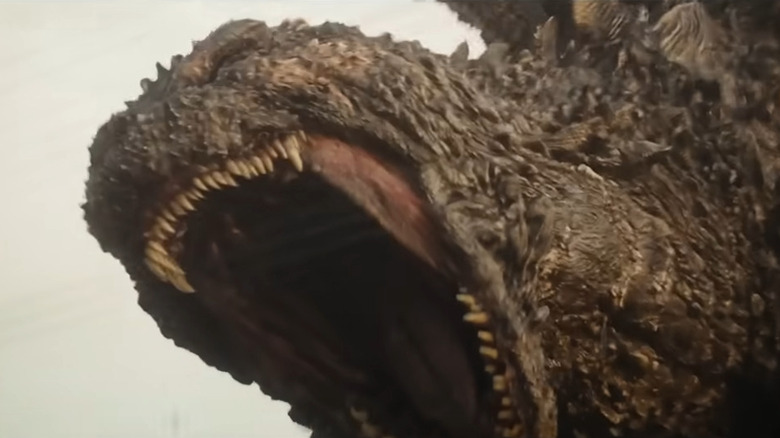Godzilla Minus One Review: An Optimistic, Post-WWII Jaws Riff
Takashi Yamazaki's "Godzilla Minus One" comes out just prior to the 70th anniversary of Ishiro Honda's 1954 original "Gojira," and audiences have been on quite a journey throughout those decades.
By the lore of Honda's film, Godzilla was a massive amphibious animal created by nuclear bomb test radiation. He was more than a dinosaur that could be defeated by weapons. He was a physical manifestation of post-war nuclear devastation, a monstrous legacy of what weapons of mass destruction have wrought. Mass destruction only leads to more mass destruction. The 1954 film's scientists ultimately have to invent an even more devastating weapon, the Oxygen Destroyer, to defeat the beast. It is a somber, sad movie about how Japan — about how humanity — is unable to break a cycle of wartime annihilation. It wouldn't be until 1995's "Godzilla vs. Destoroyah," however, that a monster would rise from the remnants of the Oxygen Destroyer.
Since the original, Godzilla has changed meaning multiple times. Throughout the Showa era of the 1960s and 1970s, as additional, more outlandish monsters began to manifest themselves nearby, Godzilla begrudgingly became Japan's bouncer. Whenever space aliens or three-headed dragons appeared, Godzilla would pound down his last slug of PBR, roll his cigarettes up in his sleeve, and kick out the uppity reptilian ruffians. After multiple appearances, Godzilla went from being a villain to an outright symbol of Japanese national pride. He was the destructive resentment left behind by a wounded nation.
In "Godzilla Minus One," the monster has now come to represent a revisionist historical corrective.
Godzilla with shoulders
"Godzilla Minus One" opens with a monster attack. Godzilla is seen, full-bodied, within the first four minutes of the film. Director Yamazaki has made a career directing action films, anime, and ride-like theme park attraction movies (including "Godzilla the Ride: Giant Monsters Ultimate Battle," exhibited at Seibuen in Tokorozawa), so his approach to Godzilla is openly designed to slake the audience's thirst for mayhem. Godzilla is a more human-shaped figure this time around, possessed of expressive "angry" eyes, wrathful fists, and a pair of studly, bodybuilders' shoulders. This is in contrast to the monster from Hideaki Anno's and Shinji Higuchi's 2016 film "Shin Godzilla," which depicted the G-Man as a writhing, terrifying biological oddity with dead eyes and useless arms.
When Yamazaki's Godzilla tears into buildings or attacks civilians, one can see, with exhilarating clarity, every piece of concrete flying through the air with a video-game-like precision. When this Godzilla stomps on the ground, planks of stone buckle up under his feet. "Godzilla Minus One" may have some of the best, most exciting destruction visuals in the franchise's long history.
"Minus" is about a kamikaze pilot named Shikishima (Ryunosuke Kamiki) who, by dint of his survival, has failed at his most recent mission. When regrouping on Odo island with his battalion, Godzilla — only about 20 feet tall — attacks, killing everyone but Shikishima and the engineer Tachibana (Munetaka Aoki). Shikishima has survivor's guilt two times over, something that increases in the ensuing years as he tries to settle into a postwar life with his girlfriend Noriko (Minami Hamabe) and the young orphan they adopted.
This Godzilla is a metaphor not for nuclear devastation, but for war trauma.
Avoiding the somber cynicism of Honda's original film, however, "Minus" begins skewing into an uncharacteristic optimism.
Breaking the cycle of wartime
There is a lot of dialogue in "Godzilla Minus One" devoted to pacifism and survival. The film's central scientist, an energetic nerd named Kenji (Hidetaka Yoshioka) devises a plan to destroy Godzilla without weapons; he hopes to sink Godzilla down to the bottom of the Pacific where water pressure ought to crush him, then rocket him back to the surface, aiming to give him a lethal case of the bends. This time, Kenji says repeatedly, no one will die. Rather than ponder the destruction, "Godzilla Minus One" aims to highlight survival as a central noble trait. It relitigates stubborn wartime notions of self-sacrifice, replacing them with persistence. This, after two hours of Shikishima pondering whether or not his death would have prevented all the destruction; was his refusal to die on the battlefield a mere act of increasingly compounded failure? "My war isn't over yet," he gravely intones. A light note of existential doubt is, of course, welcome in an otherwise exciting, action-forward Godzilla movie.
The notions in "Minus" aren't terribly profound — most action movies, you'll find, center on themes of triumph and survival — but it is a curious turn for a series that traditionally centers on monsters, horror, and destruction. "Shin Godzilla" was about how a massive governmental bureaucracy isn't prepared for natural disasters. In the more sensational, enjoyable, kid-friendly Godzilla films of the '60s and the '90s, Godzilla himself is the hero, laying waste to interlopers and aliens. "Godzilla Minus One" is one of the rare Godzilla pictures about the indomitability of the human spirit.
Godzilla's legacy
Yamazaki isn't wholly detached from Godzilla's legacy, however. He includes the requisite shots of Godzilla rising up out of the water, crushing buildings, and letting his nuclear breath blast holes in the landscape. Those who watch Godzilla movies for monster action will find themselves deeply satisfied; there is not one single Godzilla attack that takes place at night in the rain, a detail for which I am entirely grateful. Yamazaki also includes Akira Ifukube's classic Godzilla military march on the soundtrack, a piece of music that is as invaluable to Godzilla as John Williams' opening fanfare is to "Star Wars."
The only area in which "Godzilla Minus One" flags is in its lack of horror. Godzilla feels more like an enemy combatant than a proper monster. His growth from a 20-foot creature to a 200-foot creature happens off-screen and is merely mentioned in dialogue. He's a problem to handle rather than a character unto himself. This Godzilla seems to be motivated by little more than a generic action hero's sense of bland, steely resolve. When I watch Godzilla movies, I like to sense that the Big Man has a point of view on the world. He'll keep his job at Japan's metaphorical bar door, kicking out drunken Gigans and Battras, but would be just as content taking shots and having long naps on Monster Island.
This Godzilla more closely resembles Jaws than the original Godzilla. Indeed, there is a boat scene reminiscent of "Jaws" about halfway through the film, wherein everyone's favorite gorilla-whale swallows a mine. Of course, using Godzilla to make a post-WWII "Jaws" riff is hardly a terrible idea.
/Film Rating: 8 out of 10



